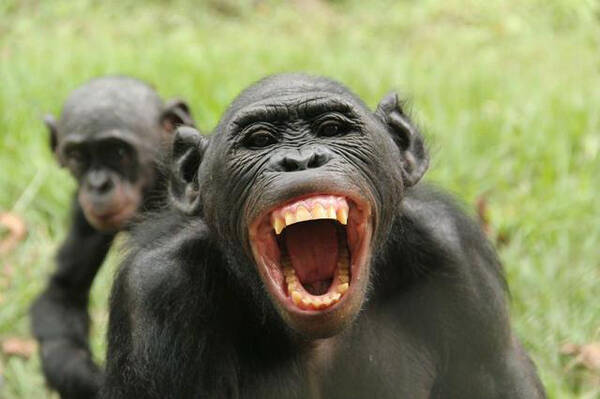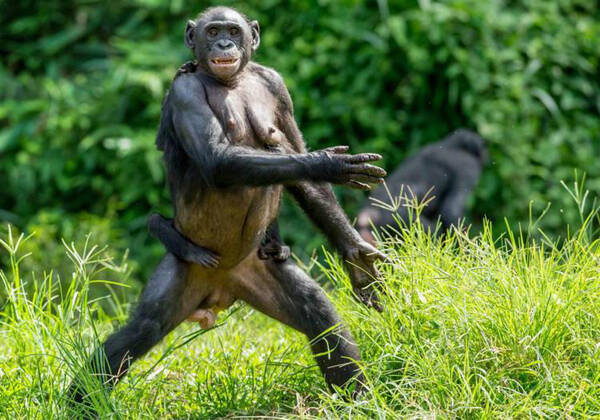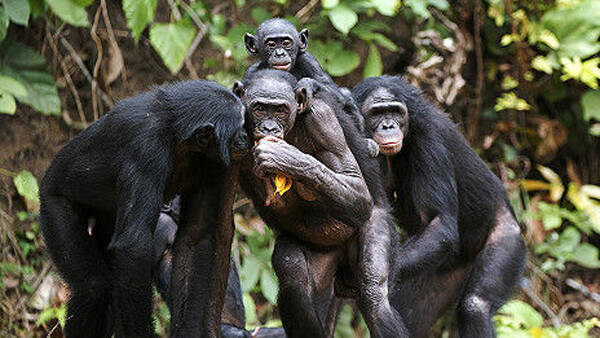Pan paniscus
IUCN
LCBasic Information
Scientific classification
- name:Pan paniscus
- Scientific Name:Pan paniscus,Dwarf Chimpanzee,Bonobo, pygmy chimpanzee
- Outline:Primates
- Family:Hominidae Chimpanzee
Vital signs
- length:70-83cm
- Weight:30-45kg
- lifetime:About 40 years
Feature
Much smaller than chimpanzees, more upright, more docile, and less likely to get angry
Distribution and Habitat
Distributed in Central Africa, the Congo River Basin, the Democratic Republic of the Congo, and the south side of the Congo River.
It only lives in the tropical rainforest on the south bank of the Congo River.
Appearance
The length of the bonobo is 73-83 cm for males and 70-76 cm for females. The weight is 40-45 kg for males and 30 kg for females. The hair on the body is short and black, usually with a white spot on the buttocks. The face is gray-brown, and the hands and feet are gray and covered with sparse black hair. The nose, ears, hands and feet of young gorillas are all flesh-colored. The ears are very large and protrude to the sides. The eye sockets are deep, the brow ridge is very high, and the hair on the top of the head is backward. The hands are 24 cm long. The canine teeth are well developed and the tooth pattern is the same as that of humans. There is no tail. There is no gluteal callus. The forelimbs can be longer than the knees, and there is little hair on the face. The body shape of the bonobo is much smaller than that of the chimpanzee, less than half the weight of the chimpanzee. The body is also thinner, with longer hair, narrower shoulders, rounder heads, red lips, smaller ears, and
Details
Bonobos (scientific name: Pan paniscus) are called Dwarf Chimpanzee in foreign language. They are one of the two species of chimpanzees and have no subspecies.

Bonobos are highly intelligent and social animals. They live in stable areas and live in groups of up to 150 members, although this usually splits into smaller groups of 2 to 20 or more, led by an adult female, when foraging and moving. They have a large appetite, mainly fruits, but also eat leaves, rhizomes, flowers, seeds and bark. This species relies more on plant rhizomes than chimpanzees. Occasionally, they also eat insects, bird eggs or catch small vertebrates, and the prey obtained by males is allowed to be shared by members of the group.
Duke University researchers found that bonobos, close relatives of humans, have a hobby of sharing with their own kind. Sharing was once considered a unique feature of humans. Other unique features of humans include the use of language, war memory, and cooperative reproduction. But the peculiarity of bonobos is that they prefer to share food with strangers rather than familiar ones. This move is aimed at expanding social networks, similar to our behavior on social networks.

Bonobos are highly promiscuous animals, engaging in more frequent mating than other primates, ranging from heterosexual to homosexual relationships. Their frequent mating is thought to strengthen their social bonds and eliminate most conflicts. They have a strong tolerance and allow sexual behavior to occur at any time they want to mate and between individuals who are satisfied with each other. Even young individuals are addicted to this sexual game, but males will no longer mate with their mothers after they are over 6 years old. When mating, it does not just mount like other apes, but in various postures similar to humans, such as face to face and mounting. There is no specific breeding season, and mating can be carried out all year round. The swollen buttocks of females indicate that they are receptive to mating. The gestation period is 8 to 9 months, and each litter has one baby; the lactation period is about 1 to 2 years. Females only give birth to one baby bonobo every 5 to 6 years. Bonobos reach sexual maturity at about 12 years. Lifespan is about 40 years.
Once, about 10,000 bonobos were only found in the south of the Congo River and its tributary, the Kasai River, in the humid rainforest of the Democratic Republic of Congo in Central Africa. Both species are endangered due to habitat loss and bushmeat hunting during civil wars. At most, only a few thousand bonobos remain. Attempts to study the habitat of bonobos began in the 1970s. However, these efforts have been sporadic due to geographic and political reasons. The endangered wild bonobos (estimated to be between 6,000 and 10,000 individuals) survive in dense, inaccessible rainforests in the Democratic Republic of the Congo.
Bonobos have a discontinuous distribution range in the Congo River Basin in the low-lying central Congo River. Their potential range is estimated to be about 500,000 square kilometers. Throughout their historical range, small populations of bonobos experience barriers to gene flow. Due to the dispersal pattern of bonobos, the effective population size of males is smaller than that of females. Population genetics analysis shows that the bonobo population has a stable population history. Through surveys conducted by various non-governmental organizations in the southern part of the Congo Basin and south of the Kasai River, there were 100,000 bonobos in 1980, but by 2012, there were less than 10,000 left.

Since researchers began sequencing chimpanzees in 2005, it has been known that we share 99% of our DNA with chimpanzees, making them our closest relatives. However, there are actually two primates that are most closely related to humans - bonobos (Pan paniscus) and chimpanzees (Pan troglodytes). This has led scientists to speculate whether the ancestor of humans, chimpanzees and bonobos looked and moved more like a bonobo, chimpanzee, or something else, and how the three species have become so different since the human ancestor split from the common ancestor of bonobos and chimpanzees in Africa between 7 million and 4 million years ago. The researchers also found that bonobos share about 98.7% of their DNA with humans - a percentage that is consistent with the rate humans share with chimpanzees. When the Max Planck scientists compared the bonobo genome directly with chimpanzee and human genomes, they found a small amount of the genome - about 1.6% - that humans share with bonobos but not with chimpanzees. And an equal amount of DNA is shared between humans and chimpanzees but not with bonobos. These differences suggest that the original population of great apes that gave rise to humans, chimpanzees and bonobos was quite large and genetically diverse - about 27,000 breeding individuals. Once the ancestors of humans separated from the ancestors of bonobos and chimpanzees more than 4 million years ago, the ancestors of bonobos and chimpanzees maintained this diversity until their populations completely split into two populations 1 million years ago. The functions of these small differences in DNA in these three species are still unknown, but scientists at the Max Planck Society have found clues that some of them may be related to genes involved in immune response regulation, tumor suppression, and social cue perception. In addition, the study of the bonobo genome will also help us understand humans ourselves.
Listed in the 2008 Red List of Endangered Species of the World Conservation Union (IUCN) ver 3.1 - Endangered (EN).
Listed in the CITES Appendix I of the Washington Convention on International Trade in Endangered Species.
Protect wild animals and stop eating game.
Maintaining ecological balance is everyone's responsibility!








